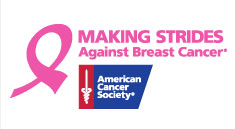
Come join the fundraising 5K walk event, Making Strides Against Breast Cancer on Saturday, October 10th 2015 at Liberty Park - 500 East 900 South Salt Lake City, Utah.
For more information visit: http://makingstrides.acsevents.org/site/PageServer?pagename=MSABC_CY15_FindAnEvent
This month is Breast Cancer Awareness Month and it is to
help recognize the threat that breast cancer is prevalent, especially among women
in the US. It is to help those who are fighting
cancer and what we, as a community, can do to help them and future individuals as
well. We want to help them recognize
early signs of breast cancer, how you can check, and what to do from there.
Recognize the Signs:
According to the America Cancer Society, some signs and
symptoms are:
- Swelling
of all or part of a breast (even if no distinct lump is felt)
- Skin
irritation or dimpling
- Breast
or nipple pain
- Nipple
retraction (turning inward)
- Redness,
scaliness, or thickening of the nipple or breast skin
- A
nipple discharge other than breast milk
If any of these symptoms are found then please report to
your doctor for a proper screening and possible diagnosis.
Help to Reduce the Risks and Fight Early Breast Cancer:
According to the CDC the steps you can take to try to lower
risks are:
- Keep a healthy weight.
- Exercise
regularly (at least four hours a week).
- Get
enough sleep.
- Don’t
drink alcohol, or
limit alcoholic drinks to no more than one per day.
- Avoid
exposure to chemicals
that can cause cancer (carcinigens).
- Try to
reduce your exposure
to radiation during medical tests like mammograms, X-rays, CT
scans, and PET scans.
- If you
are taking, or have been told to take, hormone replacement
therapy or oral contraceptives (birth
control pills), ask your doctor about the risks and find out if it is
right for you.
- Breastfeed your
babies, if possible.
Another way to help is to get a breast cancer
screening. If cancer is detected earlier
enough, it is easier to remove/and or treat.
The different ways that you can check are through mammograms, clinical
breast exams, and breast self-exams. Also,
be aware that if breast cancer runs in your family, then you are at higher risk
for breast cancer.
Steps for a Breast Self-Exam according to the American
Cancer Society:
1.
Lie down on your back and place your right arm
behind your head.
2.
Use the 3 middle fingers on your left hand to
feel for lumps in the right breast. Use
overlapping dime-sized circular motions of the finger pads to feel the breast
tissue. Use the 3 different pressure
levels to feel all the breast tissue (light, medium, and firm). If anything feels out of the ordinary then
notify your doctor.
3.
Move around the breast in an up and down pattern
starting at an imaginary line drawn straight down your side from the underarm
and moving across the breast to the middle of the chest bone (sternum or
breastbone). Be sure to check the entire breast area going down until you feel
only ribs and up to the neck or collar bone (clavicle).
4.
Repeat on your left breast with left arm behind
your head and using your right hand.
Cancer is a sensitive topic to our community and is
something that we as individuals can help fight, even for those who do not have
it does not mean we cannot help. With
support and resources that the community provides, it can help those who have
cancer.
No comments:
Post a Comment